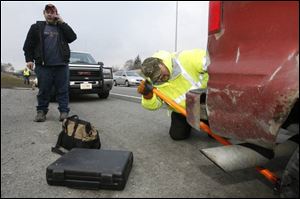
Roving ODOT vehicle dashes to the aid of motorists in need
1/26/2006
ODOT highway technician Brian Amos positions a jack under the rear of Joseph Riggs' disabled van, as Mr. Riggs calls a relative to explain he has help on the scene along I-475 at Central Avenue.
Joseph Riggs wasn't sure what to make of the white pickup with flashing yellow lights that pulled up behind his van 20 minutes after it sustained a flat tire on eastbound I-475 at Douglas Road about 4 p.m. Tuesday.
"I thought, 'Man, what did I do?' " said Mr. Riggs, who was waiting for his father to drive over from East Toledo to help him change the tire.
But the driver of white truck was there to help, not write a ticket.
Within minutes, Brian Amos, an Ohio Department of Transportation highway technician driving the department's Freeway Incident Response Service Team truck, had jacked up the van and was working on getting its spare tire out from underneath.
"This is great," Mr. Riggs said before calling back his father to wave him off: "Somebody from ODOT is here to help me."
The tire change took 18 minutes - about three times longer than Mr. Amos sets as his standard goal, but it was complicated by stuck rear doors on the van that hindered retrieving the spare. With Mr. Riggs' consent, he solved that problem by snipping the cable that lashed the spare to the van's undercarriage. Mr. Riggs was back on the road by about the time he had expected his father to arrive.
Changing tires and assisting motorists who have run out of fuel represent the "majority of stops" that the FIRST truck has made since ODOT introduced it to the Toledo area on Dec. 19, said Terry Leach, the department's transportation administrator for Lucas County.
Now in its fifth full week of operation - the truck was sidelined the week of Jan. 9 while its local operators received supplemental training - the crews have responded to more than 230 breakdowns and accidents, or an average of more than 10 a day.
Mr. Amos' afternoon shift on Tuesday was relatively slow: just three service stops.
"Some nights it's real slow, and the next night you can't get from one to the next quick enough," he said.
Mr. Amos, who occasionally is teamed with a partner, and his morning counterparts primarily patrol I-75 and I-475 in Toledo and its nearby suburbs looking for breakdowns and debris in the road and assisting police at accident scenes. The morning shift runs from 4:30 a.m. to noon; the afternoon shift is from 11:30 a.m. to 7 p.m. - all on Mondays through Fridays.
There is no charge for the FIRST truck's service, and Mr. Amos said the crews won't accept tips, either. The only condition for service is that the recipient must first sign a liability waiver.
ODOT's philosophy about the service is that clearing disabled vehicles, removing debris, and assisting police at accident scenes reduces crashes. The FIRST truck is assigned exclusively to freeway service, and in Toledo it primarily works parts of I-75 and I-475 that have heavy traffic and narrow shoulders.
For now, the ODOT vehicle is a half-ton GMC Sierra pickup, but local staff members have been lobbying department headquarters to send a burlier truck to the Northwood Outpost, where the Toledo-area FIRST operation is based. The one-ton heavy pickups used in Columbus are strong enough to tow a disabled tractor-trailer a short ways to get it off an active lane, Mr. Amos said.
That capability could have helped with his first service stop on Tuesday, which involved a semi that had broken down at the top of the exit ramp from southbound I-475/U.S. 23 at Central Avenue in Sylvania Township. When Mr. Amos arrived, the truck was unoccupied, but just as a state trooper he summoned arrived, the trucker returned from a nearby gas station where he had gone to call for a heavy tow truck. The trooper stayed on the scene until the tow truck arrived, Mr. Amos said.
The final stop of a very quiet rush hour involved a gray Chevrolet pickup on the shoulder of northbound I-75, just north of the I-280 junction, seemingly unoccupied and with a flat left-rear tire. Mr. Amos stopped, jotted down information in his log, then walked up to check for anyone inside and any sign that it might be a stolen vehicle.
Finding neither to be true, he lighted two flares behind the pickup, radioed a report, and left. Passing southbound 10 minutes later, Mr. Amos observed that one of AAA Northwest Ohio's assistance trucks was on the scene, along with a third vehicle.
The FIRST truck occasionally comes across motorists waiting for AAA assistance. Sometimes those folks welcome the earlier help from ODOT; others choose to wait for the auto club, Mr. Amos said. In the latter cases, Mr. Amos may wait with the disabled vehicle until AAA arrives as an extra safety measure.
"We're not here to take AAA's business away," but if a club member requests help, it is given, Mr. Amos said.
Lori Ghesquiere, a spokesman for AAA Northwest Ohio, said the auto club doesn't mind the "competition" from ODOT because its main concern is that all breakdowns be repaired or removed from the road safely.
Contact David Patch at:
dpatch@theblade.com
or 419-724-6094.